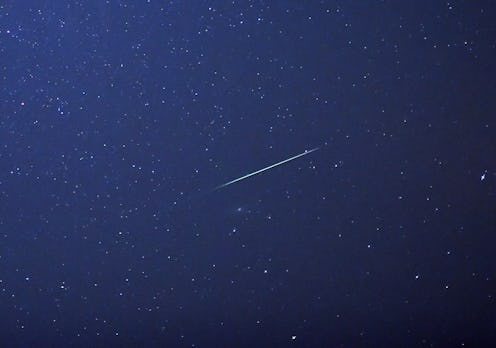Life
Everything You Wanted To Know About Meteor Showers
Everyone has that question they're too embarrassed to ask, and after all the astronomical craziness that's been going on this fall, yours might be, "What is a meteor shower?" You probably knew the specifics at one point, but unless you're an avid stargazer, that knowledge was probably displaced by more earthly concerns over the years. Although celestial knowledge is fun to show off at parties, it doesn't really help you figure out taxes.
Meteor showers make regular appearances on social media; it feels like every few weeks, everyone's all aflutter over the next big event: The Perseids occurred in August, the Draconids in October, and this month, the Taurids are expected to peak on Nov. 4 and 5 in the Northern hemisphere.
So what is a meteor shower, exactly? First, you'll need to understand meteors themselves. According to NASA, they're initially classified as meteoroids, or chunks of rock and debris floating through space, until they hit a planet's atmosphere. "[Meteoroids] become meteors — or shooting stars — when they fall... leaving a bright trail as they are heated to incandescence by the friction of the atmosphere," NASA explains on its website. That brightness is what we see from our view on the ground.
Meteors can fall one at a time, but a meteor shower occurs when Earth passes through a group of meteroids called a meteor stream. Usually, the meteor stream originates from the trail left by comets, which also orbit the Sun, albeit in a different manner. A comet's orbit is far more elliptical than Earth's, and they may spend hundreds of years in the outer solar system before traveling near the Sun again. However, the trail of debris left remains behind, and whenever Earth passes through a comet's orbit, we experience a meteor shower.
Meteor showers streak across the sky, but they appear to originate from the same region; this spot is known as the radiant. Showers are named after the constellations corresponding to the radiant's location. For example, the Delta Aquarids in July are named after the brightest stars in the Aquarius constellation, and the Perseids derive their name from the Perseus constellation.
Although meteor showers are more common than you might think — this year, NASA made a list of seven notable showers to watch — you aren't always able to see them. Moonlight and light pollution can outshine a meteor shower, and your geographical position can affect your view as well. EarthSky.org recommends choosing an open viewing area and checking the weather to see if cloud cover will obscure your view. But there's good news: You don't need a telescope to see a meteor shower, so as long as you have a clear, dark sky, you're set.
As the year draws to a close, be sure to keep an eye out for the spectacular Geminids, which are expected to peak on Dec. 13 and 14. Happy stargazing!
Images: Getty Images
